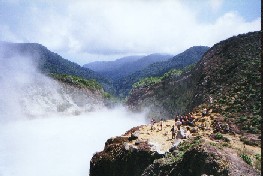About Dominica
Dominica's Geography
by: Thomson Fontaine
Dominica is situated in the Eastern Caribbean, an island between the Caribbean Sea and the North Atlantic Ocean, about one-half of the way from Puerto Rico to Trinidad and Tobago. To its immediate North is the French Island of Guadeloupe and immediate South Martinique.
Geographic coordinates: 15 25 N, 61 20 W
Area: total: Land 754 sq km (290 square miles). This is slightly more than four times the size of Washington, DC . It is also the largest in the chain of Caribbean islands.
Dominica has 148 km of coastline and a maritime claim of territorial sea equivalent to 12 nautical miles, a contiguous zone of 24 nautical miles, and an exclusive economic zone of 200 nautical miles.
 Climate: There is a tropical climate moderated by northeast trade winds and heavy rainfall. The �hot� season runs from February to May. June to November is considered the �Hurricane Season�, and December is the coolest month. Climate: There is a tropical climate moderated by northeast trade winds and heavy rainfall. The �hot� season runs from February to May. June to November is considered the �Hurricane Season�, and December is the coolest month.
Terrain: Rugged mountains of volcanic origin runs throughout the island with the highest peak, Mourne Diablotin standing at 4, 747 feet or 1, 447 meters. The lowest point is the Caribbean Sea at 0 meters.
As many as 365 rivers rushes from the mountains towards the sea, complemented by several waterfalls and a few fresh water lakes.
Dominican is known as "The Nature Island of the Caribbean" due to its spectacular, lush, and varied flora and fauna, which are protected by an extensive natural park system. It is the most mountainous of the Lesser Antilles, and its volcanic peaks are cones of lava craters and include a Boiling Lake, the second-largest, thermally active lake in the world.
Natural resources: Timber, hydropower, arable land (about 6.67%). Several crops are grown including bananas, coffee, cocoa, nutmeg, grapefruits, oranges, water melons, tangerines, mangerines, shadock, coconuts, cinnamon, vanilla, papaya, sour soup, avocadoes, yams, dasheen, plantain, pumpkins, cush cush, cassava, pineapples, and mangos. Permanent crops accounts for about 20% of production.
Natural hazards: Flash floods are a constant threat; destructive hurricanes can be expected during the late summer months; there are several active volcanoes and earthquakes occasionally threathen.
Environment - international agreements: Dominica is party to: Biodiversity, Climate Change, Climate Change-Kyoto Protocol, Desertification, Endangered Species, Environmental Modification, Hazardous Wastes, Law of the Sea, Ozone Layer Protection, Ship Pollution.
| Home | Welcome Message | Prior Issues | Feedback | Current Issue |
| Contact Us | Advertise | About Dominica | Privacy Policy |
� Copyright 2001-2007 TheDominican.Net.
Designed by Caribbean Supplies -- All Rights reserved
|
|
 |
 |
 |
 |
 |
|





